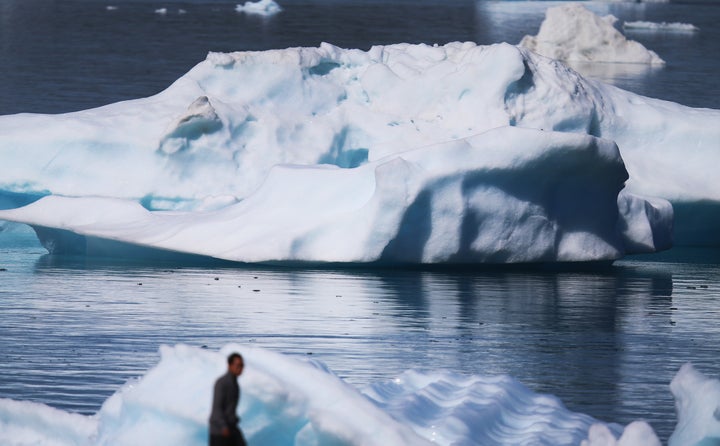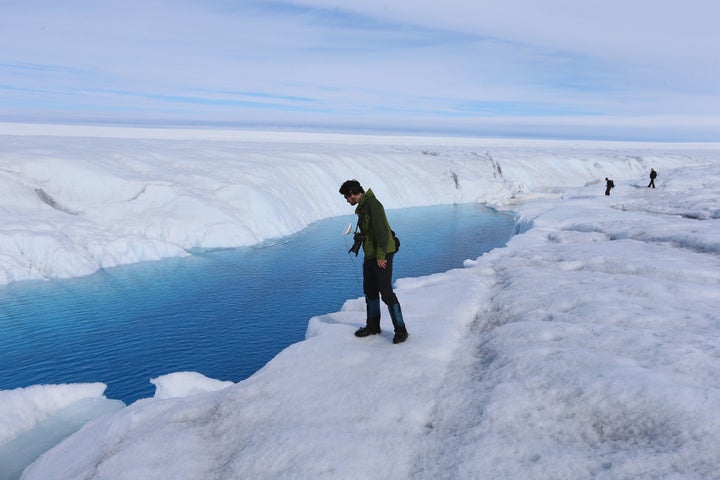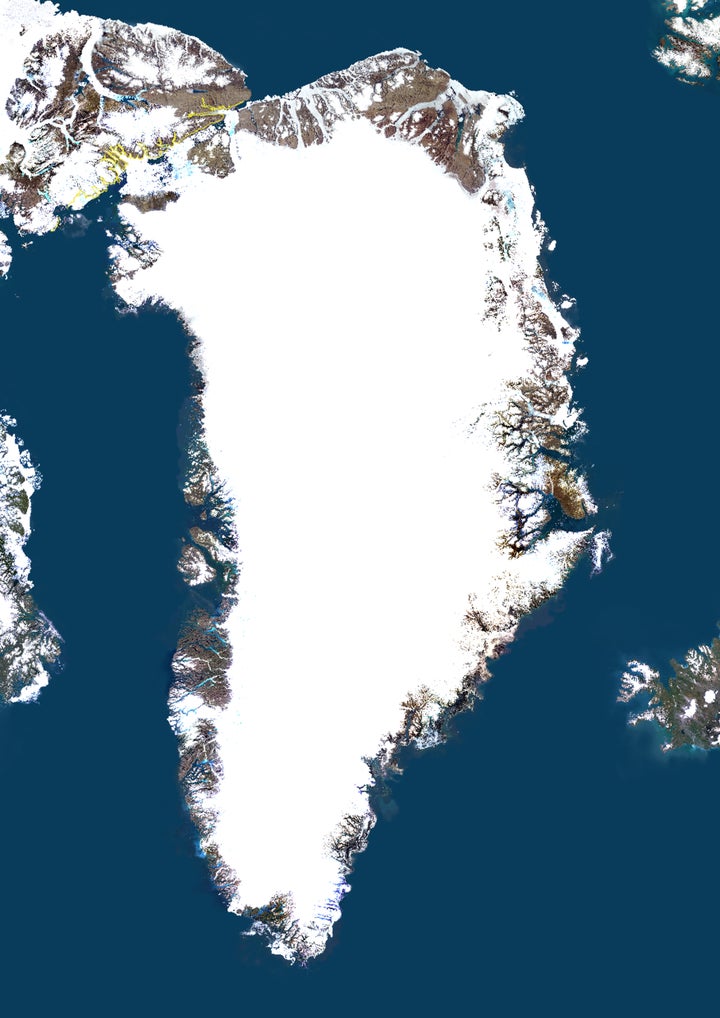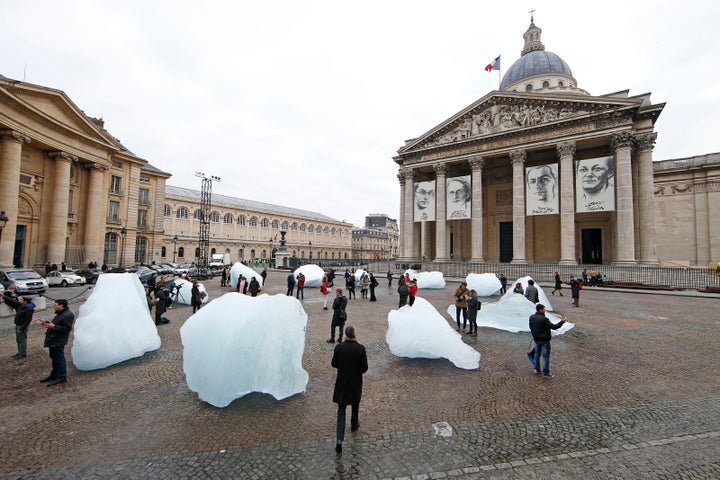
Even as President Donald Trump and his administration continue to deny the urgency of climate change, an international team of researchers has revealed how global warming has already melted Greenland’s coastal glaciers and ice caps past the point of no return.
In a study published in Nature Communications on Friday, scientists based in Europe and the U.S. describe how the glaciers and ice caps that cover tens of thousands of square miles along the coast of Greenland have reached a critical “tipping point,” beyond which further melting is unavoidable.
Troublingly, the ice had already surpassed this tipping point 20 years ago, the researchers said — only the technology to confirm this hadn’t existed until now.
“These peripheral glaciers and ice caps can be thought of as colonies of ice that are in rapid decline, many of which will likely disappear in the near future,” said Ian Howat, study co-author and glaciologist at Ohio State University, in a statement last week. “In that sense, you could say that they’re ‘doomed.’”

The complete melting of Greenland’s coastal ice could raise global sea levels by about 1.5 inches, researchers said. It’s an increase that could impact some islands and low-lying coastal areas through flooding, erosion and other effects. But according to the study’s authors, there’s much more at stake than even that.
“The [1.5 inch figure] does not sound like much,” lead author Brice Noël told The Huffington Post on Thursday from Utrecht University in The Netherlands, where he’s a doctoral researcher. “But these ice caps are an alarm signal of what will happen on the Greenland ice sheet if temperatures continue to increase.”
The Greenland ice sheet, which covers about 80 percent of the island’s surface, is the second-largest ice body in the world after the Antarctic ice sheet. The same processes that have caused the accelerated melting of Greenland’s coastal ice bodies could also influence the island’s massive ice sheet — with devastating results, Noël said.
“For now, the ice sheet is still safe,” he said. “Its tipping point hasn’t been crossed yet. But if warming continues, it’s very likely that it will be crossed.”
If the entire Greenland ice sheet were to melt, it would cause a global sea level rise of more than 20 feet.

Snow Like A ‘Sponge’
To understand why Greenland’s coastal glaciers and ice caps have reached the tipping point the researchers describe, you need to know how these ice bodies are formed.
Glaciers (slow-moving masses of ice) and ice caps (essentially mini ice sheets) are created when snow accumulates in an area and eventually transforms into ice. When new layers of snow fall, the compress the previous layers and eventually force them to recrystallize, forming larger and larger grains of snow that later become larger and larger crystals of ice. As the crystals grow, air pockets between them diminish, and after many years — typically, many decades — near-impermeable glacial ice forms.
But between the snow phase and the glacial ice phase, there’s an intermediate phase called “firn” ― when layers of compressed snow have yet to turn into ice. It typically takes about two winters to form firn in colder regions like Greenland, according to the National Snow and Ice Data Center in the U.S.
Firn is critical for preventing glaciers and ice caps from melting, researchers say in the new study. When snow melts on the surface of these ice bodies during the warmer months, meltwater collects in gaps in the firn on the way down to the layer of glacial ice below. The bottom layer of this meltwater will re-freeze, ensuring that the glacier or ice cap keeps its size or continues to grow.
“These peripheral glaciers and ice caps can be thought of as colonies of ice that are in rapid decline, many of which will likely disappear in the near future.”
- Ian Howat, Ohio State University
The firn, explained Noël, “works like a sponge that can buffer a large amount of meltwater.”
But Noël and his team discovered that Greenland’s coastal glaciers and ice caps have melted so quickly in the past few decades that about 20 years ago, the firn of these ice bodies became fully saturated with frozen meltwater.
In other words, there was “enough melt to fill up all the pore spaces in the snowpack,” explained Allen Pope, an NSIDC glaciologist who was not involved in the study, in an email to HuffPost on Thursday.
With nowhere else to go, the meltwater from these coastal glaciers and ice caps started running into the sea, causing these ice bodies’ rapid decline, the study says.
Until 1997, the glaciers and ice caps had been able to “contain and refreeze enough meltwater to remain stable despite temperature fluctuations,” Utrecht University said in a news release. Since then, however, they’ve been melting at an accelerated pace, losing about three times as much mass annually as they did before 1997. It’s an effect that the scientists have called “irreversible.”
“It would require decades to regrow a new, healthy snow cover that can buffer the summer melt again,” said Noël. And with temperatures continuing to rise because of climate change, this regrowth will likely be impossible.
“In a warmer climate, rainfall will increase at the expense of snowfall, further limiting the formation of a healthy snow cover,” Noël added.

Climate Change To Blame
Greenland’s coastal glaciers and ice caps measure about 35,000 square miles (about the size of Maine), and according to Utrecht University, represent the largest glacierized area on Earth outside of the Greenland and Antarctic ice sheets.
Citing earlier research, Noël said up to 30 percent of Greenland’s coastal ice is expected to disappear by 2100.
Global warming, said researchers, is a clear culprit of this precipitous decline: Higher temperatures have meant not just more meltwater production, but also less firn accumulating every year to absorb the meltwater.
Observers have known for years that Greenland’s coastal ice is shrinking, but until now, it was impossible to confirm the exact cause due to technological limitations, the study’s authors said. Ohio State glaciologist Howat said in an email that past researchers lacked three necessities: a high-resolution topographic model of the glaciers and ice caps, a detailed map of their boundaries and a high-resolution numerical model of drainage processes.
Today, however, new technology like Howat’s Greenland Ice Mapping Project Digital Elevation Model, and the Regional Atmospheric Climate Model, developed in part by Utrecht University, have allowed scientists to better understand the processes that are shrinking Greenland’s coastal ice.
The results of the study, said Noël, were “quite surprising.” His team had not expected the saturated firn to contribute so significantly to the ice’s accelerated decline, he said.
An Ice Sheet’s Uncertain Future
This information could have far-reaching implications, researchers said.
If the Earth’s temperature increases by 2 degrees Celsius, the benchmark agreed upon in the landmark Paris climate agreement, the Greenland ice sheet could experience the same accelerated melting that the island’s coastal glaciers and ice caps are facing, said Noël.
The ice sheet is larger and more climatologically isolated than the coastal ice bodies and therefore more stable, but researchers have already observed similar changes to certain parts of the ice sheet’s firn layer, said Howat. These changes are part of “an important process in increasing the rate at which the ice sheet responds to warming, even if it is much slower than the little glaciers at the periphery,” he said.
The Greenland ice sheet has been melting at an accelerated pace since 1979. A study published in December revealed that the large ice cache is less stable than previously believed.
“These ice caps are an alarm signal of what will happen on the Greenland ice sheet if temperatures continue to increase.”
- Brice Noël, Utrecht University
Trump and some members of his administration, including Scott Pruitt, the head of the Environmental Protection Agency, have denied that climate change is an immediate threat worth tackling. Trump signed an executive order last week targeting climate change regulations introduced by his predecessor Barack Obama. Trump’s call to roll back the Clean Power Plan, a regulation aimed at reducing carbon emissions from existing power plants, could significantly handicap U.S. efforts to meet its Paris Agreement commitments.
Last month, Pruitt prompted a furor when he contradicted overwhelming scientific consensus by claiming that carbon dioxide released by humans is not definitively the primary contributor to climate change.
Trump has proposed steep budget cuts at the EPA, the agency Pruitt now leads. According to reports this week, these cuts could imperil the jobs of hundreds of employees working on climate change.
______
Dominique Mosbergen is a reporter at The Huffington Post covering climate change, extreme weather and extinction. Send tips or feedback to dominique.mosbergen@huffingtonpost.com or follow her on Twitter.
